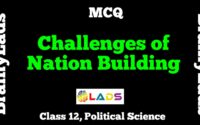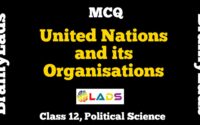MCQ of The End Of Bipolarity | Class 12 | Political Science | Term 1 |
MCQ of The End Of Bipolarity | Class 12 | Political Science | Term 1 |
1) USSR came into being after the _______ revolution in Russia in 1917
a) Communist
b) Socialist
c) Marxist
d) Capitalist
ANSWER – Socialist
2) Socialist revolution was inspired by the ideals of _______
a) Socialism
b) Marxism
c) Gandhian
d) Capitalism
ANSWER – Socialism
3) Which of the following was a drawback of the soviet system?
a) Soviet system was bureaucratic and authoritarian
b) No unemployment
c) Domestic sector industry: produced everything
d) All of the above
ANSWER – Soviet system was bureaucratic and authoritarian
4) Who invaded Afghanistan in 1979?
a) USA
b) Pakistan
c) Russia
d) Soviet Union
ANSWER – Soviet Union
5) Who became the general secretary of the Communist party of the Soviet Union in 1985?
a) Vladimir Lenin
b) Mikhail Gorbachev
c) Boris Yeltsin
d) John F. Kennedy
ANSWER – Mikhail Gorbachev
6) In which year, the coup was taken place by Communist party hardliners?
a) 1994
b) 1990
c) 1991
d) 1989
ANSWER – 1991
7) Who came up as a national hero in opposing the coup?
a) Mikhail Gorbachev
b) Fidel Castro
c) Joseph Stalin
d) Boris Yeltsin
ANSWER – Boris Yeltsin
8) In the Soviet Union, who decided to reform the society for the first time?
a) Joseph Stalin
b) Vladimir Lenin
c) Mikhail Gorbachev
d) None of the above
ANSWER – Mikhail Gorbachev
9) Russia, Ukraine and ______, three major republics of the USSR, declared that the Soviet Union was disbanded
a) Belgium
b) Georgia
c) Kosovo
d) Belarus
ANSWER – Belarus
10) Which of the following statement is true about the Soviet system?
a) State ownership was the dominant form of ownership, land and productive assets were owned by the government
b) Soviet state secured a minimum standard of living for all citizens
c) It subsidized basic necessities including health, education, childcare and other welfare schemes
d) All of the above
ANSWER – All of the above
11) Who became the successor state of the Soviet Union?
a) Belarus
b) Ukraine
c) Russia
d) Serbia
ANSWER – Russia
12) In which year, the Soviet Union was disintegrated?
a) 1996
b) 1990
c) 1991
d) 1988
ANSWER – 1991
13) What is the full form of NATO?
a) North Antarctic Treaty Organisation
b) Northwest Atlantic Treaty Organisation
c) North Arabic Treaty Organisation
d) North Atlantic Treaty Organisation
ANSWER – North-Atlantic Treaty Organisation
You may also read Challenges of Nation Building, MCQ of Planning and Development, MCQ of India’s Foreign Policy, MCQ of Cold War Era and Non Aligned Movement for better understanding of the chapters.
14) Which of the following was not a reason behind the disintegration of the Soviet Union?
a) Soviet economy used much of its resources in maintaining a nuclear and military arsenal and the development of its satellite states in Eastern Europe and within the Soviet system
b) Ordinary citizens became more knowledgeable about the economic advance of the west
c) Soviet state secured a minimum standard of living for all citizens and subsidized basic necessities including health, education, childcare and other welfare schemes
d) None of the above
ANSWER – Soviet state secured a minimum standard of living for all citizens and subsidized basic necessities including health, education, childcare and other welfare schemes
15) What is the name of Russian currency?
a) Riyal
b) Ruble
c) Rupee
d) Real
ANSWER – Ruble
16) In Russia, two republics, _______ and _______, have had violent secessionist movements
a) Amur and Atlay
b) Chechnya and Dagestan
c) Belgorod and Chukotka
d) Chuvashiya and Dagestan
ANSWER – Chechnya and Dagestan
17) In Central Asia,_______ witnessed a civil war that went on for 10 years till 2001
a) Tajikistan
b) Uzbekistan
c) Azerbaijan
d) Kazakhstan
ANSWER – Tajikistan
18) Czechoslovakia split peacefully into two, with the ______ and the ______ forming independent countries
a) Czechaso and Slovakaso
b) Area 1 and Area 2
c) Czechs and Slovaks
d) None of the above
ANSWER – Czechs and Slovaks
19) Who was the first elected president of Russia?
a) Vladimir Putin
b) Mikhail Gorbachev
c) Joseph Stalin
d) Boris Yeltsin
ANSWER – Boris Yeltsin
20) Which of the following is not a consequence of disintegration of the Soviet Union?
a) End of Cold War confrontations
b) End of the Soviet Union and emergence of many new countries
c) Formation of Warsaw pact
d) All of the above
ANSWER – Formation of Warsaw pact
21) Name the last leader of the Soviet Union
a) Vladimir Lenin
b) Boris Yeltsin
c) Nikita Khrushchev
d) Mikhail Gorbachev
ANSWER – Mikhail Gorbachev
22) When was the Berlin wall broken?
a) 9 November 1989
b) 15 December 1988
c) 5 August 1989
d) None of the above
ANSWER – 9 November 1989
23) Name the disputed area between Azerbaijan and Armenia
a) Yugoslavia
b) Nagorno-Karabakh
c) Kotayk
d) Shirak
ANSWER – Nagorno-Karabakh
24) Who was the leader of the Soviet Union at the time of Cuban missile crisis?
a) Mikhail Gorbachev
b) Nikita Khrushchev
c) Fidel Castro
d) Gamal Abdel Nasser
ANSWER – Nikita Khrushchev
25) _________ was the founder of the Bolshevik Communist party, leader of the Russian revolution of 1917 and the founder head of the USSR
a) Leonid Brezhnev
b) Vladimir Lenin
c) Boris Yeltsin
d) Mikhail Gorbachev
ANSWER – Vladimir Lenin
26) What does the Berlin wall symbolized?
a) The division between the capitalist and the communist world
b) The division between the East Korea and the West Korea
c) The division between the Socialist and the Communist world
d) None of the above
ANSWER – The division between the capitalist and the communist world
27) Which of the following statement is true about the India-Russia relationship?
a) India stands to benefit from Russia on issues like Kashmir, energy supplies, sharing information on international terrorism
b) India is the second largest arms market for Russia
c) Russia and India have collaborated on various scientific projects
d) All of the above
ANSWER – All of the above
28) Berlin wall was built in ______
a) 1962
b) 1961
c) 1965
d) 1963
ANSWER – 1961
29) Which of the following statement is not true about Boris Yeltsin?
a) He was the second elected president of Russia
b) He was made the Mayor of Moscow by Mikhail Gorbachev
c) He played a key role in dissolving the Soviet Union
d) None of the above
ANSWER – He was the second elected president of Russia
30) Soviet system was based on _______ ideology
a) Capitalist
b) Socialist
c) Gandhian
d) None of the above
ANSWER – Socialist
31) Name the party which dominated the Soviet Union’s political system?
a) Congress Party
b) People’s Party
c) Liberal Democratic Party
d) Communist Party
ANSWER – Communist party
32) Which of the following statement is true about Shock therapy?
a) Due to privatization, the society was divided into rich and poor
b) The value of Russian currency declined
c) Both A and B
d) None of the above
ANSWER – Both A and B
33) How many countries were there in the Soviet Union?
a) 14
b) 13
c) 15
d) 20
ANSWER – 15
34) What is the full form of CIS?
a) Commonwealth of Independent States
b) Commonwealth of Independent Status
c) Commonwealth of Ideologies
d) None of the above
ANSWER – Commonwealth of Independent States
35) Which of the following country was not a part of Soviet Union?
a) Latvia
b) Armenia
c) Azerbaijan
d) Iceland
ANSWER – Iceland
Do share the post if you liked the MCQ of The End Of Bipolarity. For more updates, keep logging on BrainyLads




I like the questions very much. They help a lot to prepare for exams.